
目录
一、list的介绍二、 标准库中的list类2.1 list的常见接口说明2.1.1 list对象的常见构造2.1.1.1 [无参构造函数](https://legacy.cplusplus.com/reference/list/list/list/)2.1.1.2 [有参构造函数(构造并初始化n个val)](https://legacy.cplusplus.com/reference/list/list/list/)2.1.1.3 [有参构造函数(使用迭代器进行初始化构造)](https://legacy.cplusplus.com/reference/list/list/list/)2.1.1.4 [拷贝构造函数](https://legacy.cplusplus.com/reference/list/list/list/) 2.1.2 list iterator的使用2.1.2.1 [begin()](https://legacy.cplusplus.com/reference/list/list/begin/) + [end()](https://legacy.cplusplus.com/reference/list/list/end/)2.1.2.2 [rbegin()](https://legacy.cplusplus.com/reference/list/list/rbegin/) + [rend()](https://legacy.cplusplus.com/reference/list/list/rend/) 2.1.3 list对象的容量操作2.1.3.1 [empty()函数](https://legacy.cplusplus.com/reference/list/list/empty/)2.1.3.2 [size()函数](https://legacy.cplusplus.com/reference/list/list/size/) 2.1.4 list对象的增删查改及访问2.1.4.1 [push_front()函数](https://legacy.cplusplus.com/reference/list/list/push_front/)2.1.4.2 [pop_front()函数](https://legacy.cplusplus.com/reference/list/list/pop_front/)2.1.4.3 [push_back()函数](https://legacy.cplusplus.com/reference/list/list/push_back/)2.1.4.4 [pop_back()函数](https://legacy.cplusplus.com/reference/list/list/pop_back/)2.1.4.5 [insert()函数](https://legacy.cplusplus.com/reference/list/list/insert/)2.1.4.6 [erase()函数](https://legacy.cplusplus.com/reference/list/list/erase/)2.1.4.7 [swap()函数](https://legacy.cplusplus.com/reference/list/list/swap/)2.1.4.8 [clear()函数](https://legacy.cplusplus.com/reference/list/list/clear/)2.1.4.9 [front()函数](https://legacy.cplusplus.com/reference/list/list/front/) + [back()函数](https://legacy.cplusplus.com/reference/list/list/back/) 2.1.5 list的迭代器失效 三、list的模拟实现3.1 list 节点类的实现3.2 list 中默认成员函数的实现3.3 list 中 size、empty 和 swap 函数的实现3.4 list 中 迭代器类 的实现3.5 list 中 迭代器 、 范围构造函数 和 clear 函数 的实现3.6 list 中 insert 和 erase 的实现3.7 list 中 push_back、pop_back、push_front 和 pop_front 函数的实现3.8 list 中 反向迭代器类 和 反向迭代器 的实现3.9 list 实现汇总及函数测试 四、 list 与 vector 的对比结尾
一、list的介绍
list是可以在常数范围内在任意位置进行插入和删除的序列式容器,并且该容器可以前后双向迭代。list的底层是双向链表结构,双向链表中每个元素存储在互不相关的独立节点中,在节点中通过指针指向其前一个元素和后一个元素。list与forward_list非常相似:最主要的不同在于forward_list是单链表,只能朝前迭代,已让其更简单高效。与其他的序列式容器相比(array,vector,deque),list通常在任意位置进行插入、移除元素的执行效率更好。与其他序列式容器相比,list和forward_list最大的缺陷是不支持任意位置的随机访问,比如:要访问list的第6个元素,必须从已知的位置(比如头部或者尾部)迭代到该位置,在这段位置上迭代需要线性的时间开销;list还需要一些额外的空间,以保存每个节点的相关联信息(对于存储类型较小元素的大list来说这可能是一个重要的因素)二、 标准库中的list类
2.1 list的常见接口说明
2.1.1 list对象的常见构造
2.1.1.1 无参构造函数
list();int main(){list<int> l;return 0;}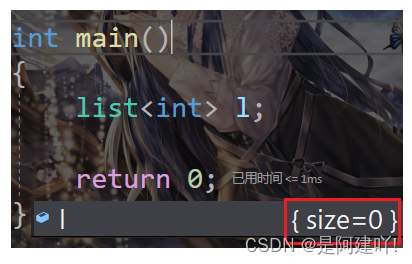
2.1.1.2 有参构造函数(构造并初始化n个val)
list (size_type n, const value_type& val = value_type());int main(){list<int> l(5, 4);return 0;}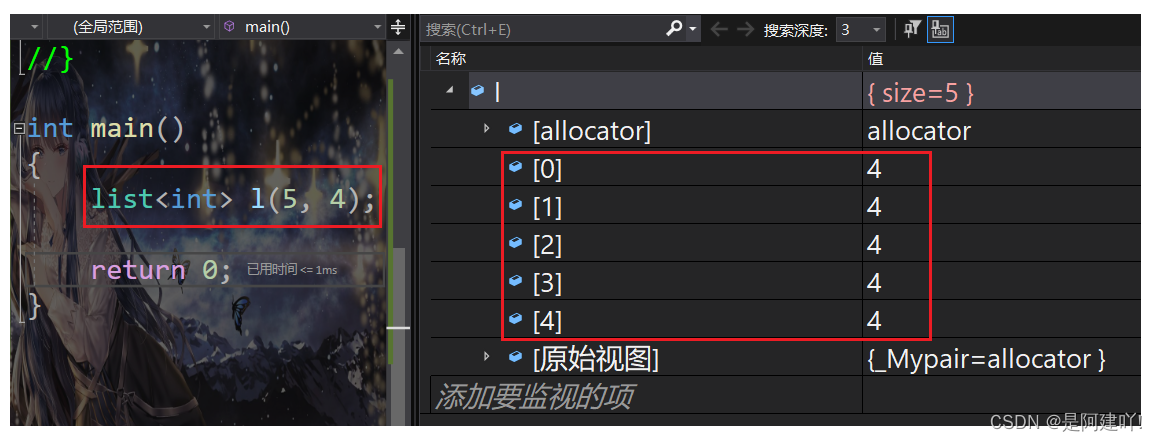
2.1.1.3 有参构造函数(使用迭代器进行初始化构造)
template <class InputIterator> list (InputIterator first, InputIterator last);int main(){string s("Love");list<int> l(s.begin(), s.end());return 0;}
2.1.1.4 拷贝构造函数
list (const list& x);int main(){list<int> l1(5,6);list<int> l2(l1);return 0;}
2.1.2 list iterator的使用
2.1.2.1 begin() + end()
iterator begin();const_iterator begin() const;获取第一个数据位置的iterator/const_iterator iterator end();const_iterator end() const;获取最后一个数据的下一个位置的iterator/const_iteratorint main(){list<int> l;for (int i = 0; i < 10; i++){l.push_back(i);}list<int>::iterator it = l.begin();while (it != l.end()){cout << *it << ' ';++it;}cout << endl;return 0;}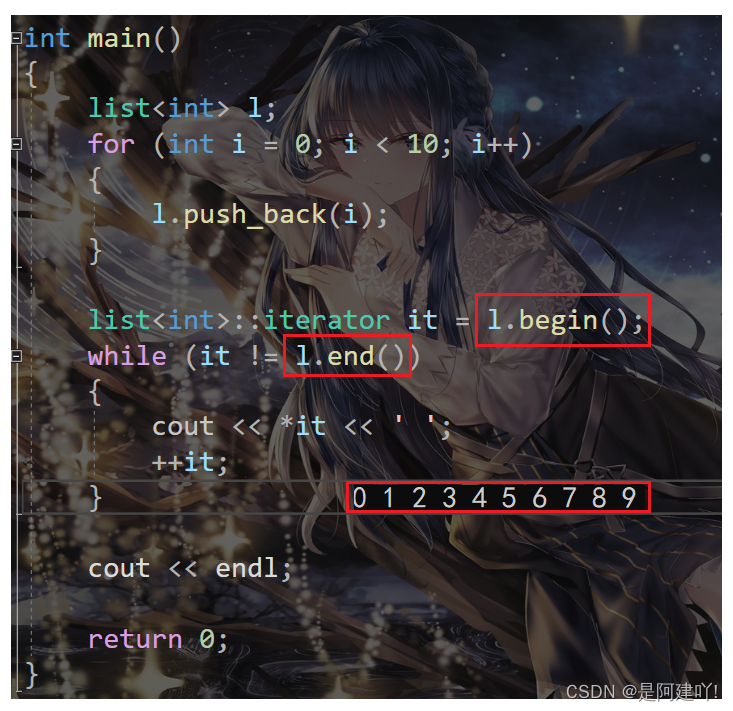
2.1.2.2 rbegin() + rend()
reverse_iterator rbegin();const_reverse_iterator rbegin() const;获取最后一个数据位置的reverse_iterator/const_reverse_iterator reverse_iterator rend();const_reverse_iterator rend() const;获取第一个数据前一个位置的reverse_iterator/const_reverse_iterator int main(){list<int> l;for (int i = 0; i < 10; i++){l.push_back(i);}list<int>::reverse_iterator it = l.rbegin();while (it != l.rend()){cout << *it << ' ';++it;}cout << endl;return 0;}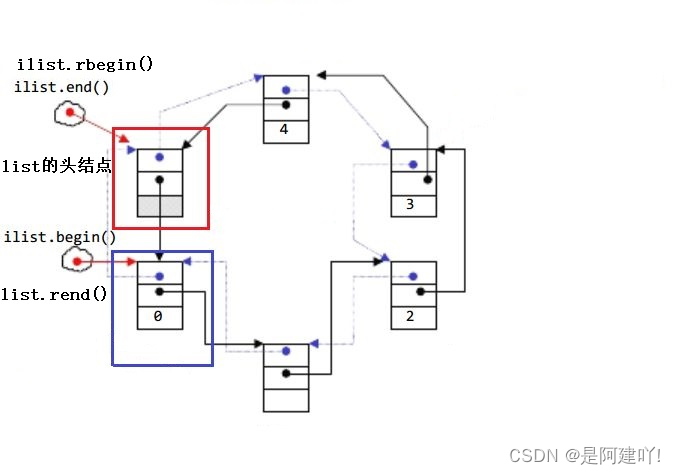
注意:
begin与end为正向迭代器,对迭代器执行++操作,迭代器向后移动rbegin与rend为反向迭代器,对迭代器执行++操作,迭代器向前移动 2.1.3 list对象的容量操作
2.1.3.1 empty()函数
bool empty() const; 判断是否为空int main(){list<int> l;cout << l.empty() << endl;l.push_back(1);cout << l.empty() << endl;return 0;}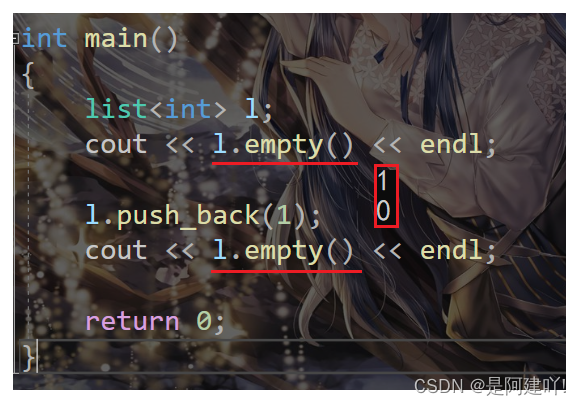
2.1.3.2 size()函数
size_type size() const; 获取数据个数int main(){list<int> l;cout << l.size() << endl;for (int i = 0; i < 10; i++){l.push_back(i);}cout << l.size() << endl;return 0;}2.1.4 list对象的增删查改及访问
2.1.4.1 push_front()函数
void push_front (const value_type& val); 头插int main(){list<int> l;l.push_front(1);l.push_front(2);l.push_front(3);l.push_front(4);for (auto e : l){cout << e << ' ';}cout << endl;return 0;}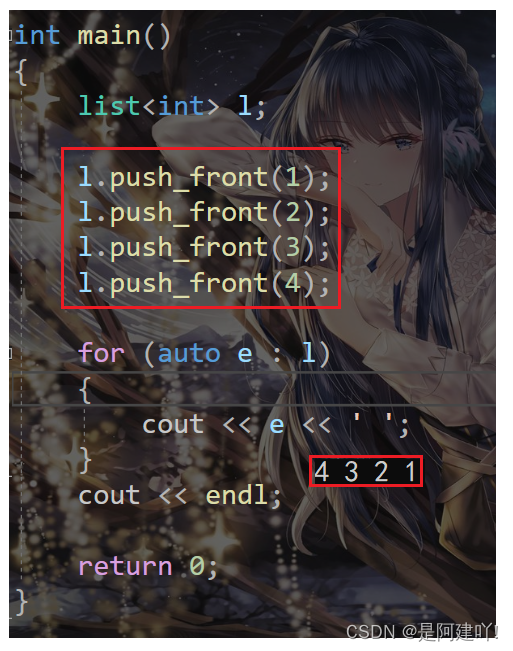
2.1.4.2 pop_front()函数
void pop_front(); 头删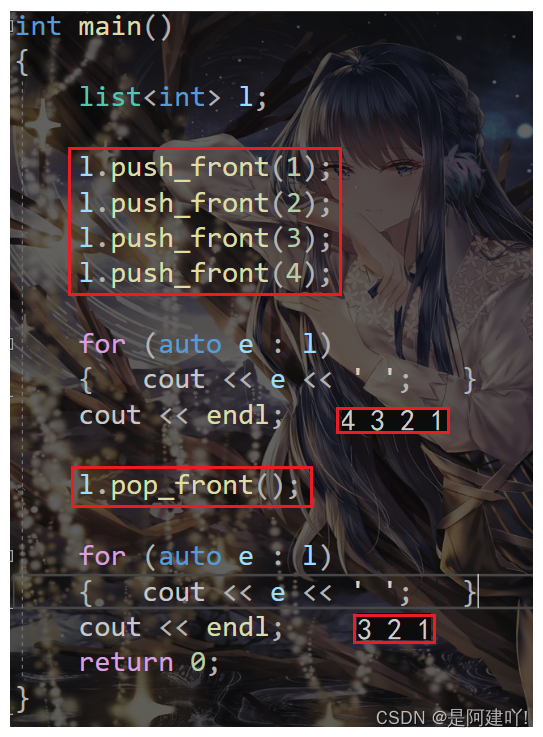
2.1.4.3 push_back()函数
void push_back (const value_type& val); 尾插int main(){list<int> l;l.push_back(1);l.push_back(2);l.push_back(3);l.push_back(4);for (auto e : l){cout << e << ' ';}cout << endl;return 0;}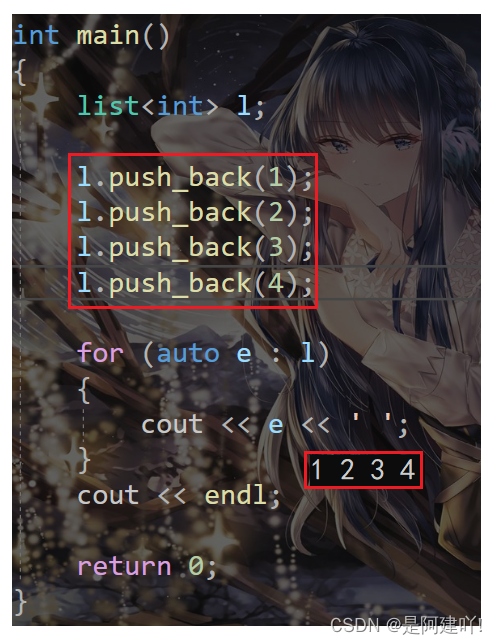
2.1.4.4 pop_back()函数
void pop_back(); 尾删int main(){list<int> l;l.push_back(1);l.push_back(2);l.push_back(3);l.push_back(4);for (auto e : l){cout << e << ' ';}cout << endl;l.pop_back();for (auto e : l){cout << e << ' ';}cout << endl;return 0;}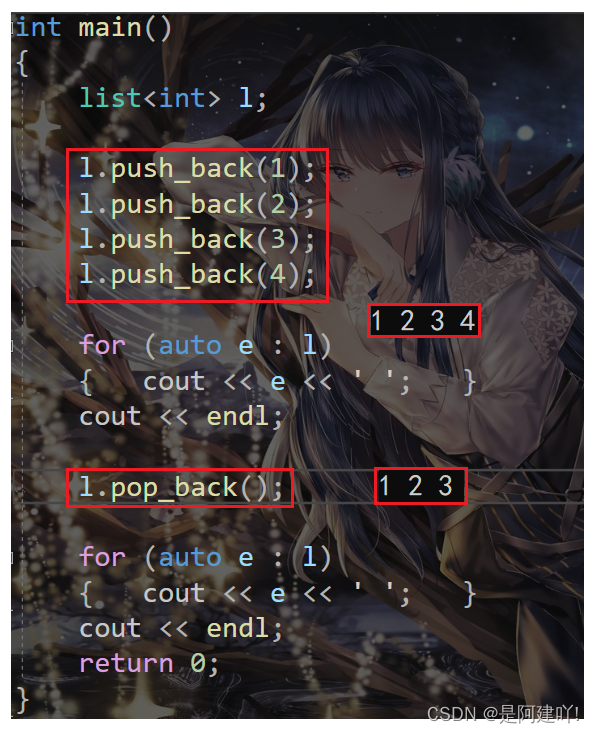
2.1.4.5 insert()函数
iterator insert (iterator position, const value_type& val);insert()函数能够在position之前插入val,并返回插入数据位置的 iterator void insert (iterator position, size_type n, const value_type& val);insert()函数能够在position之前插入 n 个 val template <class InputIterator>void insert (iterator position, InputIterator first, InputIterator last);insert()函数能够在position之前插入一段迭代器区间的数据 int main(){list<int> l;string s("Love");l.push_back(1);l.push_back(2);for (auto e : l){cout << e << ' ';}cout << endl;// insert()函数能够在position之前插入val,并返回插入数据位置的 iterator cout << *(l.insert(l.begin(), 20)) << endl;for (auto e : l){cout << e << ' ';}cout << endl;// insert()函数能够在position之前插入 n 个 val l.insert(++l.begin() , 3 ,30);for (auto e : l){cout << e << ' ';}cout << endl;// insert()函数能够在position之前插入一段迭代器区间的数据 l.insert(++l.begin(), s.begin() , s.end());for (auto e : l){cout << e << ' ';}cout << endl;return 0;}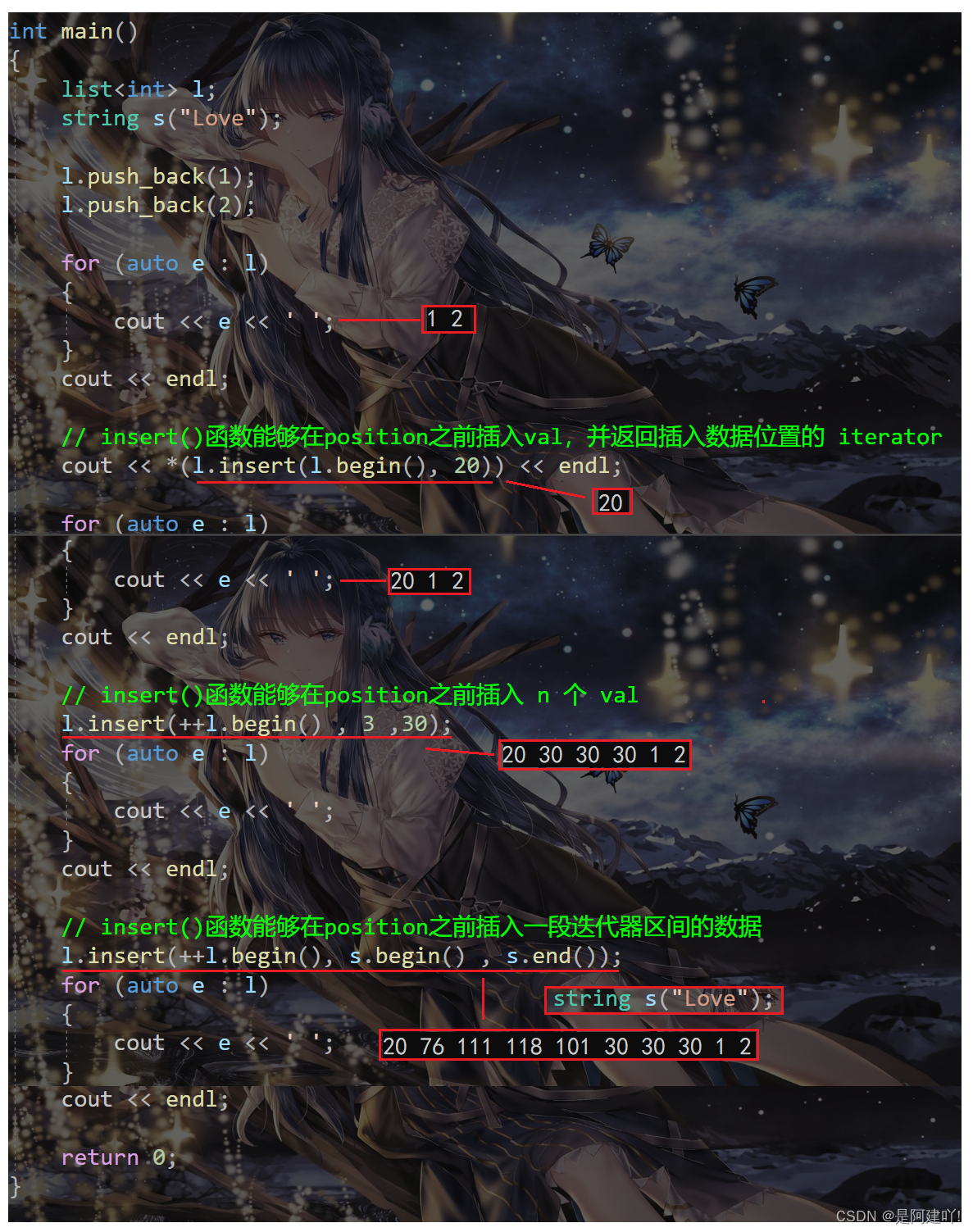
2.1.4.6 erase()函数
iterator erase (iterator position);erase()函数能够删除在position位的的数据,并返回删除数据后面数据位置的 iteratoriterator erase (iterator first, iterator last);erase()函数能够删除在迭代器区间 [first,last) 的的数据,并返回删除数据后面数据位置的 iterator int main(){list<int> l;for (int i = 0; i < 10; i++){l.push_back(i);}cout << endl;for (auto e : l){cout << e << ' ';}cout << endl;// erase()函数能够删除在position位的的数据// 并返回删除数据后面数据位置的 iteratorcout << *(l.erase(l.begin())) << endl;for (auto e : l){cout << e << ' ';}cout << endl;// erase()函数能够删除在迭代器区间 [first,last) 的的数据// 并返回删除数据后面数据位置的 iterator cout << *(l.erase(++l.begin(),--l.end())) << endl;for (auto e : l){cout << e << ' ';}cout << endl;return 0;}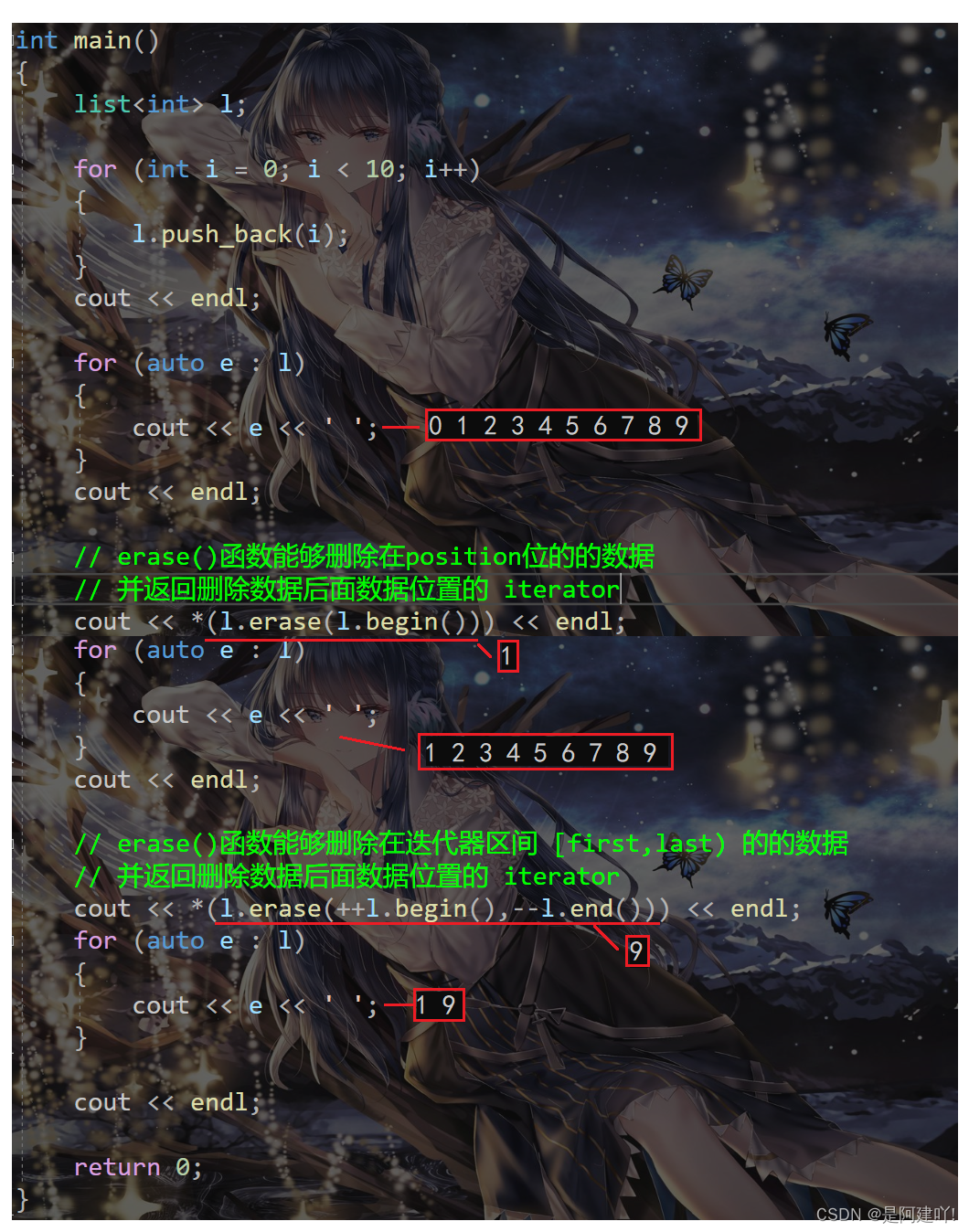
2.1.4.7 swap()函数
void swap (list& x);交换两个list的数据空间int main(){list<int> l1(4, 10);list<int> l2(5, 5);for (auto e : l1){cout << e << ' ';}cout << endl;for (auto e : l2){cout << e << ' ';}cout << endl;l1.swap(l2);for (auto e : l1){cout << e << ' ';}cout << endl;for (auto e : l2){cout << e << ' ';}cout << endl;return 0;}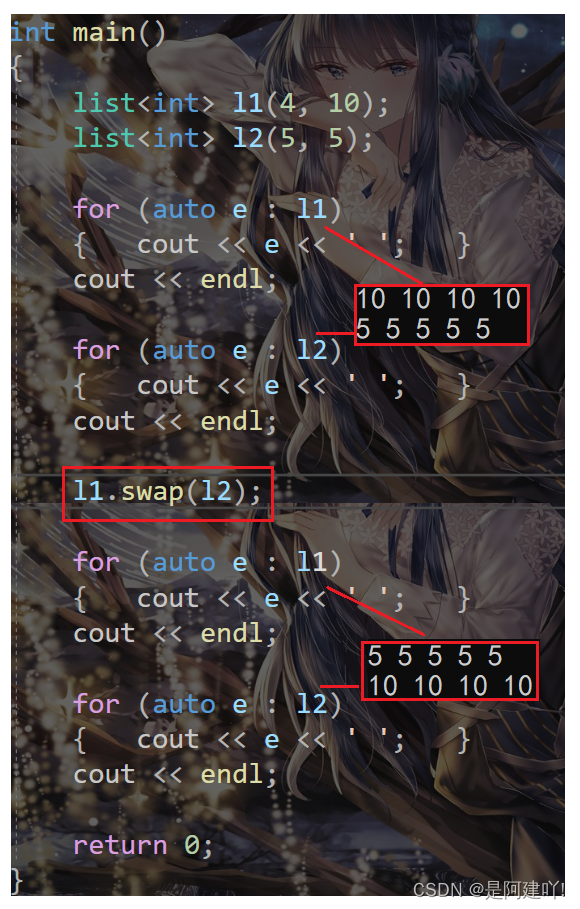
2.1.4.8 clear()函数
void clear();清除list中的有效数据int main(){list<int> l(4, 10);cout << l.size() << endl;l.clear();cout << l.size() << endl;return 0;}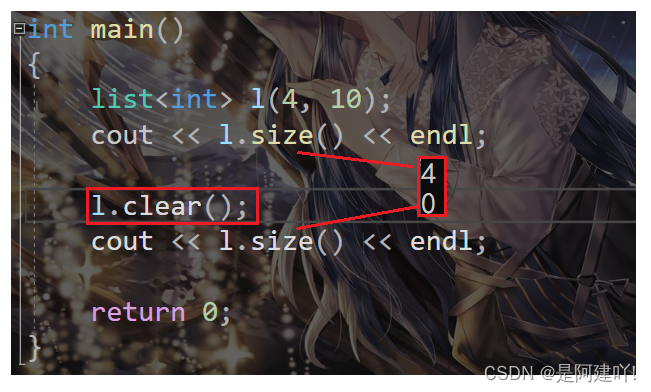
2.1.4.9 front()函数 + back()函数
访问list中的第一个数据 reference front();const_reference front() const;访问list中的最后一个数据 reference back();const_reference back() const;int main(){list<int> l;for (int i = 0; i < 10; i++){l.push_back(i);}cout << "front:" << l.front() << endl;cout << "back:" << l.back() << endl;return 0;}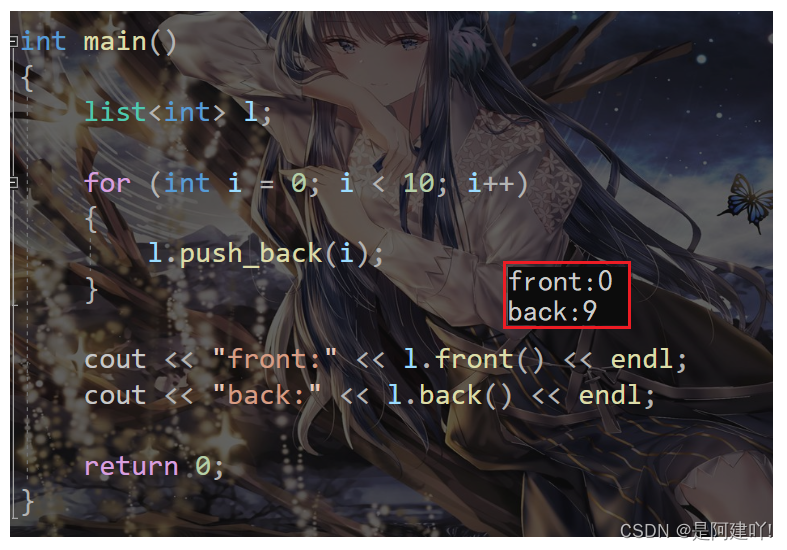
2.1.5 list的迭代器失效
前面说过,此处大家可将迭代器暂时理解成类似于指针,迭代器失效即迭代器所指向的节点的无效,即该节点被删除了。因为list的底层结构为带头结点的双向循环链表,因此在list中进行插入时是不会导致list的迭代器失效的,只有在删除时才会失效,并且失效的只是指向被删除节点的迭代器,其他迭代器不会受到影响。
int main(){int array[] = { 1, 2, 3, 4, 5, 6, 7, 8, 9, 0 };list<int> l(array, array + sizeof(array) / sizeof(array[0]));auto it = l.begin();while (it != l.end()){// erase()函数执行后,it所指向的节点已被删除// 因此it无效,在下一次使用it时,必须先给其赋值l.erase(it);++it;}return 0;}// 改正int main(){int array[] = { 1, 2, 3, 4, 5, 6, 7, 8, 9, 0 };list<int> l(array, array + sizeof(array) / sizeof(array[0]));auto it = l.begin();while (it != l.end()){l.erase(it++); // it = l.erase(it);}}三、list的模拟实现
3.1 list 节点类的实现
namespace aj{ // List的节点类 template<class T> struct ListNode { ListNode(const T& val = T()) :_val(val) {} ListNode<T>* _prev = nullptr; ListNode<T>* _next = nullptr; T _val; };};3.2 list 中默认成员函数的实现
namespace aj{ //list template<class T> class list { typedef ListNode<T> Node; typedef Node* PNode; public: // List的构造 list() { CreateHead(); } // 构造并用n个val初始化 list(int n, const T& value = T()) { CreateHead(); while (n--) { push_back(value); } } // 链表的拷贝构造 // list(const list<T>& l) list(list<T>& l) { CreateHead(); for (auto e : l) { push_back(e); } } list<T>& operator=(const list<T> l) { swap(l); return *this; } ~list() { clear(); delete _head; _head = nullptr; } void swap(list<T>& l) { std::swap(_head, l._head); std::swap(_size, l._size); } private: void CreateHead() { _head = new Node(); _head->_next = _head; _head->_prev = _head; _size = 0; } PNode _head; // 头结点 int _size; // 记录链表中节点的个数 };};3.3 list 中 size、empty 和 swap 函数的实现
namespace aj{ template<class T> class list { typedef ListNode<T> Node; typedef Node* PNode; public: size_t size()const { return size; } bool empty()const { return _head->_next == _head && _head->_prev == _head; } void swap(list<T>& l) { std::swap(_head, l._head); std::swap(_size, l._size); } private: void CreateHead() { _head = new Node(); _head->_next = _head; _head->_prev = _head; _size = 0; } PNode _head; // 头结点 int _size; // 记录链表中节点的个数 };};3.4 list 中 迭代器类 的实现
namespace aj{ //List的迭代器类 //template<class T> template<class T, class Ref, class Ptr> struct ListIterator { typedef ListNode<T>* PNode; typedef ListIterator<T, Ref, Ptr> Self; // 成员变量 PNode _pNode; public: // 迭代器的构造函数 ListIterator(PNode pNode = nullptr) :_pNode(pNode) {} Ref operator*() { return _pNode->_val; } Ptr operator->() { return &(_pNode->_val); } Self& operator++() { _pNode = _pNode->_next; return *this; } Self operator++(int) { Self tmp(*this); ++* this; return tmp; } Self& operator--() { _pNode = _pNode->_prev; return *this; } Self operator--(int) { Self tmp(*this); --* this; return tmp; } bool operator!=(const Self& l) { return _pNode != l._pNode; } bool operator==(const Self& l) { return _pNode == l._pNode; } };};3.5 list 中 迭代器 、 范围构造函数 和 clear 函数 的实现
namespace aj{ template<class T> class list { typedef ListNode<T> Node; typedef Node* PNode; public: typedef ListIterator<T, T&, T*> iterator; typedef ListIterator<T, const T&, const T&> const_iterator; template <class Iterator> list(Iterator first, Iterator last) { CreateHead(); while (first != last) { push_back(first._pNode->_val); ++first; } } // List Iterator iterator begin() { // return iterator(_head->_next); return _head->_next; } iterator end() { // return iterator(_head); return _head; } const_iterator begin()const { return _head->_next; } const_iterator end()const { return _head; } void clear() { list<T>::iterator lit = begin(); while (lit != end()) { lit = erase(lit); } } private: void CreateHead() { _head = new Node(); _head->_next = _head; _head->_prev = _head; _size = 0; } PNode _head; // 头结点 int _size; // 记录链表中节点的个数 };};3.6 list 中 insert 和 erase 的实现
namespace aj{ template<class T> class list { typedef ListNode<T> Node; typedef Node* PNode; public: typedef ListIterator<T, T&, T*> iterator; typedef ListIterator<T, const T&, const T&> const_iterator; // 在pos位置前插入值为val的节点,返回插入新节点的位置 iterator insert(iterator pos, const T& val) { // 通过迭代器找到所需的节点指针 Node* cur = pos._pNode; Node* prev = cur->_prev; // 创建新的节点 Node* newnode = new Node(val); // 节点间相互连接 newnode->_prev = prev; prev->_next = newnode; cur->_prev = newnode; newnode->_next = cur; // 节点数量++ _size++; //return iterator(newnode); return newnode; } // 删除pos位置的节点,返回该节点的下一个位置 iterator erase(iterator pos) { assert(_size > 0); // 找到所需要的节点指针 Node* cur = pos._pNode; Node* next = cur->_next; Node* prev = cur->_prev; // 节点相互连接 next->_prev = prev; prev->_next = next; // 删除节点 delete cur; cur = nullptr; // 减少节点数目 --_size; // 返回删除节点的下一个位置 // return iterator(next); return next; } private: void CreateHead() { _head = new Node(); _head->_next = _head; _head->_prev = _head; _size = 0; } PNode _head; // 头结点 int _size; // 记录链表中节点的个数 };};3.7 list 中 push_back、pop_back、push_front 和 pop_front 函数的实现
namespace aj{ template<class T> class list { public: typedef ListNode<T> Node; typedef Node* PNode; void push_back(const T& val) { insert(end(), val); } void pop_back() { erase(--end()); } void push_front(const T& val) { insert(begin(), val); } void pop_front() { erase(begin()); } private: PNode _head; // 头结点 int _size; // 记录链表中节点的个数 };};3.8 list 中 反向迭代器类 和 反向迭代器 的实现
反向迭代器的++就是正向迭代器的--,反向迭代器的--就是正向迭代器的++,因此反向迭代器的实现可以借助正向迭代器,即:反向迭代器内部可以包含一个正向迭代器,对正向迭代器的接口进行包装即可。
注意:反向迭代器类可以被所有的容器封装成反向迭代器使用。
下面两种反向迭代器的实现虽然不同,但是功能是相同的。反向迭代器类的实现不同,那么对应封装迭代器的时候也要做出相应的改变。
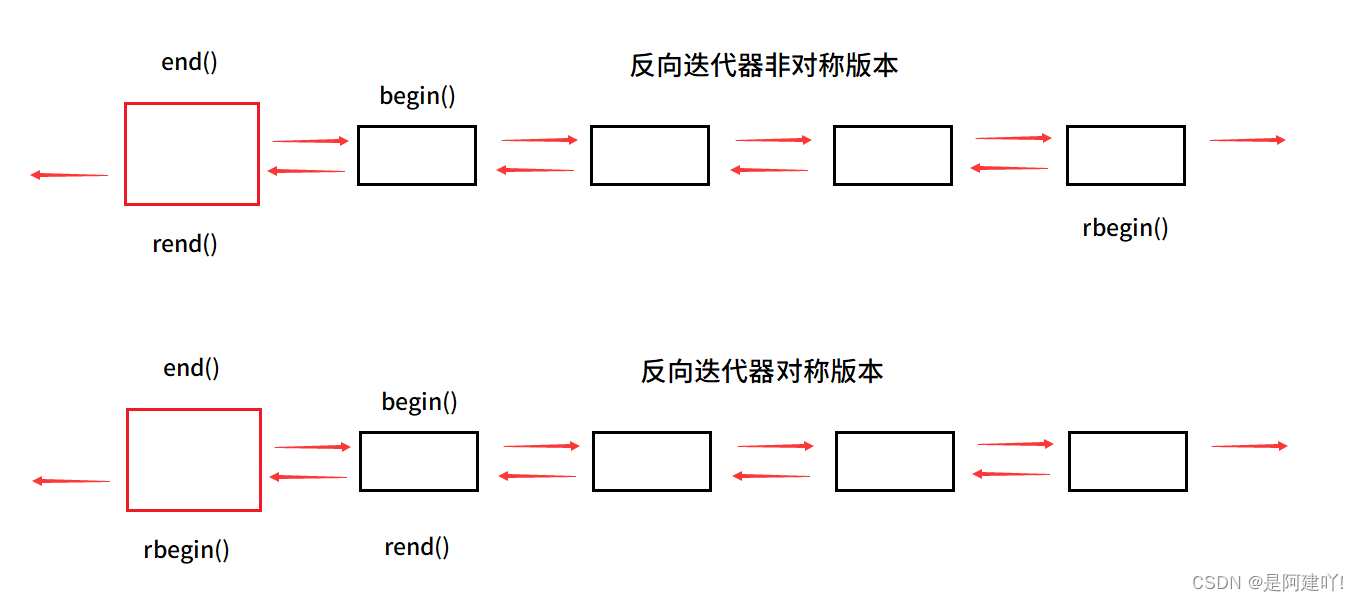
reverse_iterator.h 反向迭代器非对称版本#pragma once// 不对称版本namespace aj{// 适配器 -- 复用template<class Iterator, class Ref, class Ptr>struct Reverse_iterator{typedef Reverse_iterator<Iterator,Ref,Ptr> Self;Reverse_iterator(const Iterator& it):_it(it){}Ref operator*(){return *_it;}Ptr operator->(){return _it.operator->();}Self& operator++(){--_it;return *this;}Self operator++(int){Self tmp(*this);--_it;return tmp;}Self& operator--(){++_it;return *this;}Self operator--(int){Self tmp(*this);++_it;return tmp;}bool operator!=(const Self& s){return _it != s._it;}bool operator==(const Self& s){return _it == s._it;}Iterator _it;};}list.h 反向迭代器非对称版本#include"reverse_iterator.h"namespace aj{ template<class T> class list { public: typedef ListNode<T> Node; typedef Node* PNode; public: // typedef ListIterator<T> iterator; typedef ListIterator<T, T&, T*> iterator; typedef ListIterator<T, const T&, const T&> const_iterator; typedef Reverse_iterator<iterator, T&, T*> reverse_iterator; typedef Reverse_iterator<const_iterator, const T&, const T*> const_reverse_iterator; public: // reverse_iterator 不对称版本 reverse_iterator rbegin() { // return iterator(_head->_next); return --end(); //这里可以使用--end()也可以使用end()-1,但是没有写operator-() } //这里就使用--end(),这里能使用--end()的原因是 //end()返回传值返回的自定义类型的临时对象,具有常性,是常量 //但是这里有编译器的特殊处理 //使得const对象可以调用非const成员函数 reverse_iterator rend() { // return iterator(_head); return end(); } const_reverse_iterator rbegin()const { return --end(); } const_reverse_iterator rend()const { return end(); } private: void CreateHead() { _head = new Node(); _head->_next = _head; _head->_prev = _head; _size = 0; } PNode _head; // 头结点 int _size; // 记录链表中节点的个数 };};reverse_iterator.h 反向迭代器对称版本#pragma once// 对称版本namespace aj{// 适配器 -- 复用template<class Iterator, class Ref, class Ptr>struct Reverse_iterator{typedef Reverse_iterator<Iterator,Ref,Ptr> Self;Reverse_iterator(const Iterator& it):_it(it){}Ref operator*(){Iterator tmp(_it);return *--tmp;}Ptr operator->(){return --_it.operator->();}Self& operator++(){--_it;return *this;}Self operator++(int){Self tmp(*this);--_it;return tmp;}Self& operator--(){++_it;return *this;}Self operator--(int){Self tmp(*this);++_it;return tmp;}bool operator!=(const Self& s){return _it != s._it;}bool operator==(const Self& s){return _it == s._it;}Iterator _it;};}list.h 反向迭代器对称版本#include"reverse_iterator.h"namespace aj{ template<class T> class list { public: typedef ListNode<T> Node; typedef Node* PNode; public: // typedef ListIterator<T> iterator; typedef ListIterator<T, T&, T*> iterator; typedef ListIterator<T, const T&, const T&> const_iterator; typedef Reverse_iterator<iterator, T&, T*> reverse_iterator; typedef Reverse_iterator<const_iterator, const T&, const T*> const_reverse_iterator; public: // reverse_iterator 对称版本 reverse_iterator rbegin() { // return iterator(_head->_next); return end(); } reverse_iterator rend() { // return iterator(_head); return begin(); } const_reverse_iterator rbegin()const { return end(); } const_reverse_iterator rend()const { return begin(); } private: void CreateHead() { _head = new Node(); _head->_next = _head; _head->_prev = _head; _size = 0; } PNode _head; // 头结点 int _size; // 记录链表中节点的个数 };};3.9 list 实现汇总及函数测试
reverse_iterator.h#pragma once// 不对称版本//namespace aj//{//// 适配器 -- 复用//template<class Iterator, class Ref, class Ptr>//struct Reverse_iterator//{//typedef Reverse_iterator<Iterator,Ref,Ptr> Self;////Reverse_iterator(const Iterator& it)//:_it(it)//{}////Ref operator*()//{//return *_it;//}////Ptr operator->()//{//return _it.operator->();//}////Self& operator++()//{//--_it;//return *this;//}////Self operator++(int)//{//Self tmp(*this);//--_it;//return tmp;//}////Self& operator--()//{//++_it;//return *this;//}////Self operator--(int)//{//Self tmp(*this);//++_it;//return tmp;//}////bool operator!=(const Self& s)//{//return _it != s._it;//}////bool operator==(const Self& s)//{//return _it == s._it;//}//Iterator _it;//};//}// 对称版本namespace aj{// 适配器 -- 复用template<class Iterator, class Ref, class Ptr>struct Reverse_iterator{typedef Reverse_iterator<Iterator,Ref,Ptr> Self;Reverse_iterator(const Iterator& it):_it(it){}Ref operator*(){Iterator tmp(_it);return *--tmp;}Ptr operator->(){return --_it.operator->();}Self& operator++(){--_it;return *this;}Self operator++(int){Self tmp(*this);--_it;return tmp;}Self& operator--(){++_it;return *this;}Self operator--(int){Self tmp(*this);++_it;return tmp;}bool operator!=(const Self& s){return _it != s._it;}bool operator==(const Self& s){return _it == s._it;}Iterator _it;};}list.h#pragma once#include<iostream>#include<assert.h>#include <string>#include <vector>using namespace std;#include"reverse_iterator.h"namespace aj{ // List的节点类 template<class T> struct ListNode { ListNode(const T& val = T()) :_val(val) {} ListNode<T>* _prev = nullptr; ListNode<T>* _next = nullptr; T _val; }; //List的迭代器类 //template<class T> template<class T, class Ref, class Ptr> struct ListIterator { typedef ListNode<T>* PNode; typedef ListIterator<T ,Ref , Ptr> Self; // 成员变量 PNode _pNode; // typedef ListIterator<T, Ref, Ptr> Self; public: // 迭代器的构造函数 ListIterator(PNode pNode = nullptr) :_pNode(pNode) {} Ref operator*() { return _pNode->_val; } Ptr operator->() { return &(_pNode->_val); } Self& operator++() { _pNode = _pNode->_next; return *this; } Self operator++(int) { Self tmp(*this); ++* this; return tmp; } Self& operator--() { _pNode = _pNode->_prev; return *this; } Self operator--(int) { Self tmp(*this); --* this; return tmp; } bool operator!=(const Self& l) { return _pNode != l._pNode; } bool operator==(const Self& l) { return _pNode == l._pNode; } }; //list类 template<class T> class list { public: typedef ListNode<T> Node; typedef Node* PNode; public: // typedef ListIterator<T> iterator; typedef ListIterator<T, T&, T*> iterator; typedef ListIterator<T, const T&, const T&> const_iterator; typedef Reverse_iterator<iterator, T&, T*> reverse_iterator; typedef Reverse_iterator<const_iterator,const T&,const T*> const_reverse_iterator; public: /// // List的构造 list() { CreateHead(); } list(int n, const T& value = T()) { CreateHead(); while (n--) { push_back(value); } } template <class Iterator> list(Iterator first, Iterator last) { CreateHead(); while (first != last) { push_back(first._pNode->_val); ++first; } } // 链表的拷贝构造 // list(const list<T>& l) list(list<T>& l) { CreateHead(); for (auto e : l) { push_back(e); } } //list<T>& operator=(const list<T> l) list<T>& operator=(list<T> l) { swap(l); return *this; } ~list() { clear(); delete _head; _head = nullptr; } /// // List Iterator iterator begin() { // return iterator(_head->_next); return _head->_next; } iterator end() { // return iterator(_head); return _head; } const_iterator begin()const { return _head->_next; } const_iterator end()const { return _head; } reverse_iterator 不对称版本 //reverse_iterator rbegin() //{ // // return iterator(_head->_next); // return --end(); //这里可以使用--end()也可以使用end()-1,但是没有写operator-() //} //这里就使用--end(),这里能使用--end()的原因是 // //end()返回传值返回的自定义类型的临时对象,具有常性,是常量 // //但是这里有编译器的特殊处理 // //使得const对象可以调用非const成员函数 //reverse_iterator rend() //{ // // return iterator(_head); // return end(); //} //const_reverse_iterator rbegin()const //{ // return --end(); //} //const_reverse_iterator rend()const //{ // return end(); //} // reverse_iterator 对称版本 reverse_iterator rbegin() { // return iterator(_head->_next); return end(); } reverse_iterator rend() { // return iterator(_head); return begin(); } const_reverse_iterator rbegin()const { return end(); } const_reverse_iterator rend()const { return begin(); } /// // List Capacity size_t size()const { return size; } bool empty()const { return _head->_next == _head && _head->_prev == _head; } // List Access T& front() { assert(_head->_next != _head); return _head->_next->_val; } const T& front()const { assert(_head->_next != _head); return _head->_next->_val; } T& back() { assert(_head->_prev != _head); return _head->_prev->_val; } const T& back()const { assert(_head->_prev != _head); return _head->_prev->_val; } // List Modify void push_back(const T& val) { insert(end(), val); } void pop_back() { erase(--end()); } void push_front(const T& val) { insert(begin(), val); } void pop_front() { erase(begin()); } // 在pos位置前插入值为val的节点,返回插入新节点的位置 iterator insert(iterator pos, const T& val) { // 通过迭代器找到所需的节点指针 Node* cur = pos._pNode; Node* prev = cur->_prev; // 创建新的节点 Node* newnode = new Node(val); // 节点间相互连接 newnode->_prev = prev; prev->_next = newnode; cur->_prev = newnode; newnode->_next = cur; // 节点数量++ _size++; //return iterator(newnode); return newnode; } // 删除pos位置的节点,返回该节点的下一个位置 iterator erase(iterator pos) { assert(_size > 0); // 找到所需要的节点指针 Node* cur = pos._pNode; Node* next = cur->_next; Node* prev = cur->_prev; // 节点相互连接 next->_prev = prev; prev->_next = next; // 删除节点 delete cur; cur = nullptr; // 减少节点数目 --_size; // 返回删除节点的下一个位置 // return iterator(next); return next; } void clear() { list<T>::iterator lit = begin(); while (lit != end()) { lit = erase(lit); } } void swap(list<T>& l) { std::swap(_head, l._head); std::swap(_size, l._size); } private: void CreateHead() { _head = new Node(); _head->_next = _head; _head->_prev = _head; _size = 0; } PNode _head; // 头结点 int _size; // 记录链表中节点的个数 }; struct AA { AA(int a1 = 0 , int a2 = 0) :_a1(a1) ,_a2(a2) {} int _a1; int _a2; }; //template<class T> //void print_list(const list<T>& l) //{ // // list<T>未实例化的类模板,编译器不能去他里面去找 // // 那么编译器就无法确定这里的 // // const_iterator是静态变量还是内嵌类型 // // 加上typename就相当于告诉编译器这里是内嵌类型 // // 等list<T>初始化后再到类中去取 // typename list<T>::const_iterator it = l.begin(); // while (it != l.end()) // { // cout << *it << ' '; // ++it; // } // cout << endl; //} template<class Container> void print_container(const Container& l) { typename Container::const_iterator it = l.begin(); while (it != l.end()) { cout << *it << ' '; ++it; } cout << endl; }/// // 测试无参构造、n个val的构造、迭代器区间构造 void test_list1() { list<int> l; l.push_back(1); l.push_back(2); l.push_back(3); l.push_back(4); l.push_back(5); list<int> l1(10, 20); list<int> l2(++l1.begin(), --l1.end()); for (auto e : l) { cout << e << ' '; } cout << endl; for (auto e : l1) { cout << e << ' '; } cout << endl; for (auto e : l2) { cout << e << ' '; } cout << endl; } // 测试 insert push_back push_front // 测试 iterator 范围for // 测试 operator != operator* void test_list2() { list<int> l; l.push_back(1); l.push_back(2); l.push_back(3); l.push_back(4); l.push_back(5); l.push_front(10); l.push_front(20); list<int>::iterator lit = l.begin(); while (lit != l.end()) { cout << *lit << ' '; ++lit; } cout << endl; for (auto& e : l) { e += 10; cout << e << ' '; } cout << endl; } // 测试 erase pop_back pop_front void test_list3() { list<int> l; l.push_back(1); l.push_back(2); l.push_back(3); l.push_back(4); l.push_back(5); for (auto e : l) { cout << e << ' '; } cout << endl; l.pop_back(); for (auto e : l) { cout << e << ' '; } cout << endl; l.pop_front(); for (auto e : l) { cout << e << ' '; } cout << endl; } // 测试 operator++ operator++(int) // 测试 operator-- operator--(int) void test_list4() { list<int> l; l.push_back(1); l.push_back(2); l.push_back(3); l.push_back(4); l.push_back(5); list<int>::iterator lit1 = l.begin(); cout << *(lit1++) << endl; cout << *(++lit1) << endl; list<int>::iterator lit2 = l.end(); cout << *(--lit2) << endl; cout << *(lit2--) << endl; cout << endl; } // 测试 operator== operator!= void test_list5() { list<int> l; l.push_back(1); l.push_back(2); l.push_back(3); l.push_back(4); l.push_back(5); list<int>::iterator lit = l.end(); cout << (lit == lit) << endl; cout << (lit != lit) << endl; cout << endl; } void test_list6() { list<int> l; l.push_back(1); l.push_back(2); l.push_back(3); for (auto e : l) { cout << e << ' '; } cout << endl; cout << l.front() << ' ' << l.back() << endl; l.pop_back(); l.pop_front(); for (auto e : l) { cout << e << ' '; } cout << endl; cout << l.front() << ' ' << l.back() << endl; l.pop_back(); l.pop_front(); for (auto e : l) { cout << e << ' '; } cout << endl; cout << l.front() << ' ' << l.back() << endl; } // 测试 operator-> void test_list7() { list<AA> l1; l1.push_back(AA(1, 1)); l1.push_back(AA(2, 2)); l1.push_back(AA(3, 3)); l1.push_back(AA(4, 4)); list<AA>::iterator it = l1.begin(); while (it != l1.end()) { cout << it->_a1 << ' ' << it->_a2 << endl; ++it; } } // 测试拷贝构造和赋值重载 void test_list8 () { list<int> l1; l1.push_back(1); l1.push_back(2); l1.push_back(3); l1.push_back(4); // 拷贝构造l2 list<int> l2(l1); // 输出l1和l2的值 for (auto e : l1) { cout << e << ' '; } cout << endl; for (auto e : l2) { cout << e << ' '; } cout << endl; // l2中的值都*10,并输出 for (auto& e : l2) { e *= 10; cout << e << ' '; } cout << endl; // 将l2赋值给l1 l1 = l2; // 输出l1和l2的值 for (auto e : l1) { cout << e << ' '; } cout << endl; for (auto e : l2) { cout << e << ' '; } cout << endl; } // 测试print_container void test_list9() { list<int> l1; l1.push_back(1); l1.push_back(2); l1.push_back(3); l1.push_back(4); print_container(l1); list<string> l2; l2.push_back("1111111111111111111"); l2.push_back("2222222222222222222"); l2.push_back("3333333333333333333"); l2.push_back("4444444444444444444"); print_container(l2); vector<string> v; v.push_back("1111111111111111111"); v.push_back("2222222222222222222"); v.push_back("3333333333333333333"); v.push_back("4444444444444444444"); print_container(v); } void test_list10() { list<int> l1; l1.push_back(1); l1.push_back(2); l1.push_back(3); l1.push_back(4); list<int>::reverse_iterator it = l1.rbegin(); while (it != l1.rend()) { cout << *it << ' '; ++it; } cout << endl; }};四、 list 与 vector 的对比
vector与list都是STL中非常重要的序列式容器,由于两个容器的底层结构不同,导致其特性以及应用场景不同,其主要不同如下:
| vector | list | |
|---|---|---|
| 底层结构 | 动态顺序表,一段连续空间 | 带头结点的双向循环链 |
| 访问 | 支持随机访问,访问某个元素的效率O(1) | 不支持随机访问,访问某个元素的效率为O(N) |
| 插入和删除 | 头部和中部的插入效率低,因为需要移动大量数据,效率为O(N),尾插和尾删的效率高,效率为O(1) 。插入时有可能需要增容,增容:开辟新空间,拷贝元素,释放旧空间,导致效率更低 | 任意位置的插入和删除效率高,不需要移动数据,效率为O(N) |
| 空间利用率 | 底层为连续空间,不容易造成内存碎片,空间利用率高,缓存利用率高 | 底层节点动态开辟,小节点容易造成内存碎片,空间利用率低,缓存利用率低 |
| 迭 代 器 失 效 | 在插入元素时,要给所有的迭代器重新赋值,因为插入元素有可能会导致重新扩容,致使原来迭代器失效,删除时,当前迭代器需要重新赋值否则会失效 | 插入元素不会导致迭代器失效,删除元素时,只会导致当前迭代器失效,其他迭代器不受影响 |
| 使 用 场 景 | 需要高效存储,支持随机访问,不关心插入删除效率 | 大量插入和删除操作,不关心随机访问 |
结尾
如果有什么建议和疑问,或是有什么错误,大家可以在评论区中提出。
希望大家以后也能和我一起进步!!??
如果这篇文章对你有用的话,希望大家给一个三连支持一下!!??